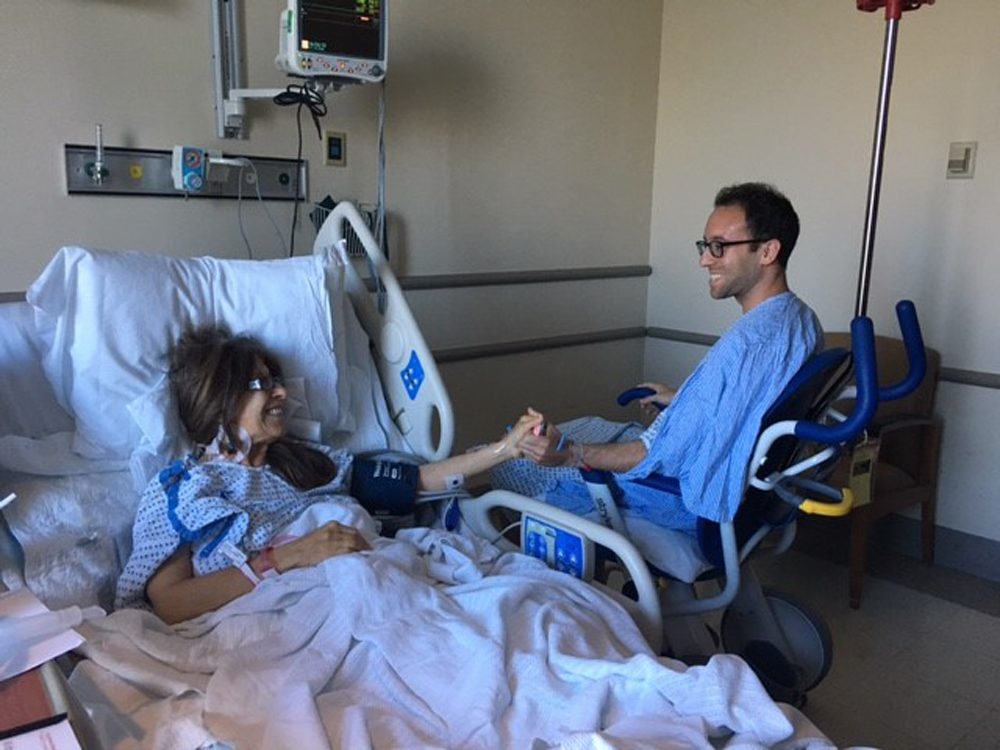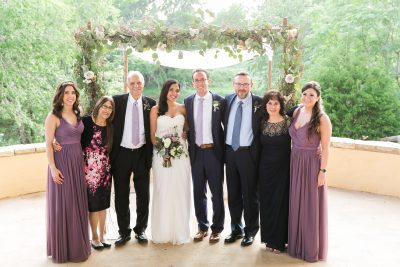Advertisement
5 Months After Donating Kidney, Steve Russolillo Ran His Best Marathon

Steven Russolillo is a daily columnist for the Wall Street Journal. A few years back, he met his now-wife, Shelly Banjo — she was working at the Wall Street Journal, too — and she told him about polycystic kidney disease. It runs in her family.
"It wasn’t on a third date, but you know, it was — I would say within the first year of dating this came up," Steve says. "Shelly’s mom would ultimately need a transplant at some point. The timing was unknown, It could be in a year, it could be in five years, it could be 10 years, who knows? But it was — this was just something that was on the horizon."
Steve says he just tried to do the things that good companions do: He listened, he comforted, he hoped for the best. Life went on. The disease progressed. Shelly’s mom, Batya, got sicker. Steve and Shelly’s relationship progressed, which led to happier developments.
"I proposed to Shelly in March, end of March, 2015. Really, the first thought that came to mind was, 'It has to be running related, somehow,'" Steve says. "It was a Sunday morning in Central Park, and I tried to make it as normal of a run as possible, like, 'Hey, Shell, let’s go running this morning.' 'OK, fine.'"
"How’d you hide a ring in running clothes?" I ask.
"So, I had it in the box and I put the box in this running jacket that I was wearing," Steve says with a laugh. "And I thought that I caught her glancing at it. And in my head I kind of freaked out: 'Oh, my God, she knows something’s up.'"
Shelly didn’t know. After running for about a mile, Steve stopped, got on one knee and proposed. Shelly’s sister was there to take pictures.
The Search For A Donor
But Batya Banjo was still getting sicker. Doctors told her it was time for a kidney transplant. The family had already started the search for a living donor.
"We put a flyer out. I mean, literally, we made this flyer, and Shelly posted it and posted it on Twitter," Steve says. "We actually had 11 people raise their hand and went and got tested."
Eleven people stepped up. Eleven people were medically disqualified.
"Each one, one after the other, you get your hopes up and you get really excited, and then, you get the bad news," Steve says. "I’m watching very interesting people step up. I’m watching complete strangers from the internet. I’m watching close friends. I watched my own aunt go and get tested. I’m sitting here thinking to myself, 'If all these people can raise their hands, why can’t I?'"
Why not, Steve? I can think of one reason. Shelly might need a kidney someday. The disease runs in her family. But Steve and Shelly decided to focus on the current need rather than worry about a potential need later. So, Steve went in for testing. At first, no one knew but Shelly. They didn’t want to get the family’s hopes up.
Advertisement
Besides, Steve had some tough questions for the doctors.
"At the time I had ran five marathons, 15 to 20 half marathons — I mean this was really important to me," he says. "It was the first thing I asked them, I said, 'Will I be able to run?' and if they had said no — oh, God. I just asked myself a difficult question. I don’t know how I would’ve responded to that. But, thank God, they said yes. So I don’t have to answer that question now. But I wanted to know what the sacrifices were ahead of time, and this would’ve been a really, really huge one for me."
"I’m watching complete strangers from the internet. I’m watching close friends. I watched my own aunt go and get tested. I’m sitting here thinking to myself, 'If all these people can raise their hands, why can’t I?'"
Steve decided the risks were minimal and the potential reward was huge. So Steve and Shelly called Batya to tell her the news.
"There was just silence at first. She was just really just speechless," Steve says. "She said, 'Ah, you’re my lifesaver.' You know, it made me a little nervous at first. It’s like, 'I didn’t do anything yet, so hold on, let’s — let’s wait a second.'"
But it wasn’t Steve who had second thoughts. It was Batya. And even though doctors said that she should have the operation right away, Batya was firm. The transplant would have to wait until after the wedding, scheduled for May 29, 2016.

"I don’t know what it was, maybe it was adrenaline, or maybe it was just positive emotions, but everything leading up to the wedding, you know, she seemed to be feeling better," Steve says. "She did an amazing hora. We did the hora twice actually at the wedding. She was amazing both times. If you didn’t know anything, she seemed to be pretty much fine. But all the medical charts would say otherwise."i
'You Saved My Life'
Three weeks later, Steve and Shelly woke up at 4 a.m. to meet her parents in New York.
"We’re all dressed in sweatpants and pajamas, and there’s like, you know, a little bit of a nervous tension," Steve says. "Shelly’s dad just turns to the doorman, and goes: 'We’re all getting ready to go play basketball.' And that just, like, really just sort of calmed everyone just a little bit right then and there."
Steve’s operation took 90 minutes. Batya’s took three hours. Both went well, though Steve was in more pain than he expected immediately after the surgery. But then came the moment that Steve and Batya had been waiting for.
"They wheeled me over into her area. She just reached out and grabbed my hand, and I grabbed her hand and she said, 'You saved my life.' And I mean it’s not every day someone says that to you. So, that was just so powerful to me."
At first, Steve — the accomplished marathon runner — says he walked so slowly that he had to find the intersections in New York City that would give him a little extra time to make it across. But Steve wanted to run.
"I remember exactly one month after the transplant, Shelly and I did this four-mile run in Central Park. This was a four-mile race. Basically, I would walk for about 10 minutes, I would very, very slowly jog for two or three minutes and then I would just repeat the process."
Steve started to get down on himself. He worried that his road to recovery — and this four-mile race — would never end.
"Shelly was — she was the best," Steve says. "She just said, 'It’s gonna be fine. You’re doing this, you’re doing this a month after the transplant. That’s just amazing in and of itself. Don’t worry about your time. Don’t worry. It doesn’t matter. You’re doing it.' At the time I was thinking to myself, 'I’m gonna do the marathon. I’m definitely gonna do the marathon. I may not do it as fast as I’d like to do it, and I better go faster than I’m going now.' But I was thinking, 'I’m gonna somehow be able to do it.'"
That was July 16. Steve had less than four months to get ready for the New York City Marathon. Steve’s doctors told him that as long as he felt good, he should keep training. As his runs got longer and faster, Steve’s wife had some more specific advice.
"Oh, man, Shelly — she kept telling me, she said, 'Don’t run faster than an eight-minute mile. Don’t run faster than it at all.' And some of these shorter runs, I’m like, 'Ah, but I feel good, come on, just let me go!' 'No, don’t do it.'"
"I guess all these emotions from everything -- from the wedding, from the honeymoon, from the transplant, from the recovery, just everything -- all these emotions were all bottled up into this one race. Letting them go and just running it -- just, I felt amazing."
Marathon Day
With each passing long run, Steve felt better. He felt stronger. Before he knew it, Nov. 6 had arrived. Bright and sunny, temperatures in the mid-50s, it was a beautiful day for a marathon. But Steve had memories of other races running through his mind.
"As most runners do, I usually hit the wall at mile 18, 19 or 20, and the last quarter of the marathon is a disaster, or whatever," Steve says. "And so I’m running this and I have Shelly’s voice in my head the whole time saying, 'Make sure you stay on your pace, stay on that eight-minute pace.'"
But by mile 12 or 13, Steve got frustrated with going so slowly. He started running faster.
"Mile 15 and 16 you go over the Queensboro Bridge — that’s the one spot in the marathon where there are basically no spectators at all, so all you’re hearing is just the footsteps and people breathing and that’s it. You know, you get over the bridge, get into Manhattan. It’s just so loud and there’s so much energy, and I start seeing a lot of my friends. I’m feeling really good, and I get to mile 19, mile 20. I’m thinking to myself, 'This is the spot that I usually just really, really start falling apart.'
"But the opposite was happening, I was actually feeling stronger. I don’t know what it was, I guess all these emotions from everything — from the wedding, from the honeymoon, from the transplant, from the recovery, just everything — all these emotions were all bottled up into this one race. Letting them go and just running it — just, I felt amazing. And I crossed the finish line, and I was so pumped up. You know, I’m usually dead after a marathon. I’m usually just so exhausted. I don’t know, I just felt absolutely amazing."
Inspiring Others To Get Out And Donate
Just five months after donating his kidney, Steve had run a personal best. And his mother-in-law is doing well, too. She followed his run online from her home in Texas.
The National Kidney Foundation says 13 people die every day waiting for a kidney and living donor rates have fallen over the past decade. But Steve Russolillo hopes that if people hear his story, maybe they’ll help reverse that trend.
"It’s funny, I have this amazing group of friends, and we all do this Hoboken Thanksgiving together. We have this tradition every year, everyone goes around and says what they’re thankful for. You know I was re-living the story again, and it’s more powerful than ever because I know how important it is, but, at the end of the day, it was not that big of a sacrifice for me. My life has not changed at all. I haven’t given up anything — I guess I’ve given up a kidney, but other than that, though, I mean, I’m living the same life that I was living beforehand. The fact that I could do this whole transplant and feel as well as I did and run as well as I did — other people can get out there and other people can donate and other people can run a marathon afterward and it will be totally fine."
"All right, but you were not saying that donating a kidney will make you a faster runner, right?" I ask.
"That’s right — causation, correlation, gotta think about that," Steve laughs.
This segment aired on November 26, 2016.
